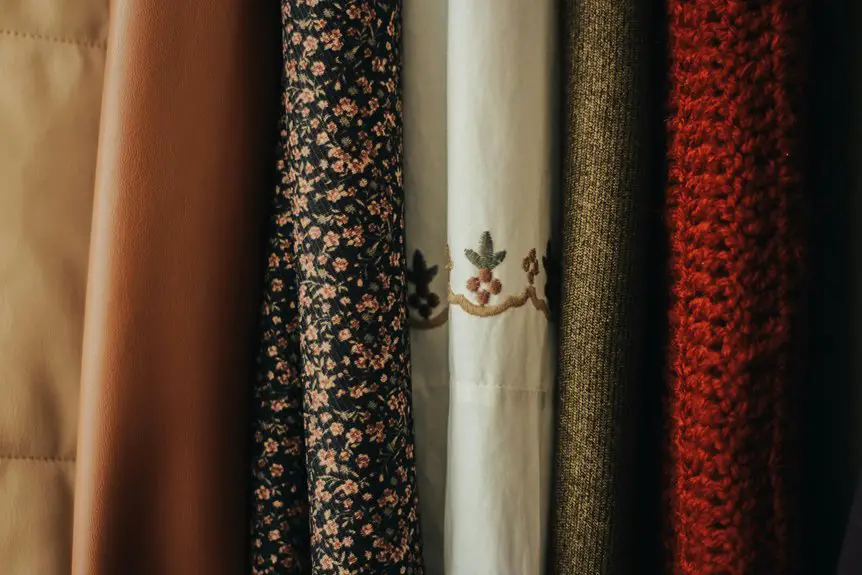When sewing cotton gauze tops, skirts, or dresses, choose loose, flowy patterns like peasant tops or A-line skirts to match the fabric’s airy texture. Prewash and handle the fabric gently to avoid distortion. Use a fine needle and short stitch length, and finish seams with French seams or bias binding for neatness. Wash garments carefully and air dry to preserve softness and shape. Keep these basics in mind, and you’ll find even more ways to create beautiful gauze garments ahead.
Table of Contents
Key Takeaways
- Choose loose, flowy patterns like peasant tops, A-line skirts, or tiered dresses to complement cotton gauze’s lightweight texture.
- Prewash fabric gently in cold water and air dry to prevent shrinkage and preserve softness before cutting and sewing.
- Use fine needles (60/8 or 70/10) and short stitch lengths (1.5–2 mm) to avoid damaging delicate gauze fibers.
- Finish seams with French seams or lightweight bias binding to encase raw edges and prevent fraying without bulk.
- Wash garments on gentle cycles with mild detergent and air dry flat or hung to maintain fabric texture and shape.
Choosing the Right Patterns for Cotton Gauze
How do you pick the best patterns for sewing with cotton gauze? You’ll want to choose designs that complement its lightweight, airy texture.
Opt for loose-fitting or flowy silhouettes like peasant tops, A-line skirts, or tiered dresses. These styles work well because cotton gauze drapes beautifully and doesn’t hold structure tightly.
Avoid patterns with heavy tailoring or too many darts and pleats, as the fabric’s softness won’t support sharp lines or fitted shapes.
Look for simple construction with minimal layers to prevent bulkiness since gauze is delicate. Patterns featuring gathers, ruffles, or bias-cut details enhance its natural drape and texture.
Preparing and Handling Cotton Gauze Fabric
Before you start cutting, spend some time properly preparing your cotton gauze fabric to guarantee smooth sewing. First, gently prewash the fabric in cold water without harsh detergents to remove sizing and prevent future shrinkage.
Avoid wringing it out; instead, press out excess water and lay it flat or hang it to air dry. When ironing, use a low heat setting and a pressing cloth to protect the delicate fibers.
Handle the fabric carefully to avoid stretching or distortion, especially since gauze tends to be lightweight and loosely woven. When cutting, use sharp scissors or a rotary cutter to achieve clean edges, and consider weighing down your pattern pieces to prevent slipping.
Taking these steps guarantees your cotton gauze stays stable and manageable throughout your project.
Stitching Techniques for Delicate Gauze
Sewing delicate cotton gauze demands gentle stitching techniques to maintain its softness and prevent damage. Use a fine needle, like a size 70/10 or 60/8, to avoid large punctures that can weaken the fabric.
Opt for a short stitch length—around 1.5 to 2 mm—to create secure seams without puckering. When sewing, handle the fabric lightly and avoid pulling or stretching it, as gauze is prone to distortion.
Consider using a straight stitch rather than a zigzag to keep seams neat and less bulky. If your machine has a walking foot, it can help feed the layers evenly.
Finally, test your stitch settings on a fabric scrap before working on your garment to guarantee the best results without damaging your gauze.
Seam Finishes and Edge Treatments
Although cotton gauze is lightweight and airy, its raw edges can fray easily, so you’ll need to choose seam finishes and edge treatments that protect your garment while preserving its delicate texture.
To keep your seams neat and durable without adding bulk, try these techniques:
- French seams: Encase raw edges for a clean, professional look perfect for sheer fabrics.
- Bias binding: Use lightweight bias tape to finish edges smoothly and add subtle detail.
- Zigzag stitch: Quickly secure edges and reduce fraying with a narrow zigzag stitch along seam allowances.
- Overlocking (serging): If you have a serger, finish edges efficiently with minimal bulk.
Pick the method that suits your project and skill level to keep your cotton gauze garments looking polished and lasting longer.
Care and Maintenance of Cotton Gauze Garments
Because cotton gauze is delicate and prone to fraying, you’ll want to handle your garments with care to maintain their softness and shape.
Always wash them gently by hand or use a delicate cycle with cold water to prevent damage. Avoid harsh detergents; opt for mild, fragrance-free soaps instead.
When drying, skip the dryer and lay your garments flat or hang them to air dry, which helps preserve the fabric’s texture and prevents shrinkage.
Iron gauze on a low setting if necessary, or use a steamer to remove wrinkles without crushing the fibers.
Store your cotton gauze garments folded or hung on padded hangers to maintain their form.
Following these steps will keep your pieces looking fresh and wearable for a long time.
Frequently Asked Questions
Can I Use Cotton Gauze for Baby Clothing?
You can definitely use cotton gauze for baby clothing because it’s soft, breathable, and gentle on sensitive skin. Just make sure to secure seams properly since the fabric is lightweight and may fray easily over time.
How Does Cotton Gauze Compare to Linen for Summer Wear?
Imagine summer’s gentle breeze wrapped in fabric form. You’ll find cotton gauze softer and airier than linen, which feels crisper and more textured. Both breathe well, but gauze drapes like a whisper against your skin.
Are There Seasonal Colors That Suit Cotton Gauze Best?
You’ll find pastel shades and soft neutrals suit cotton gauze best, especially in spring and summer. These colors highlight its airy texture, keeping your look fresh and light during warmer months. Try soft blues or blush pinks.
Can Cotton Gauze Be Layered Without Adding Bulk?
Think of cotton gauze as delicate clouds you can stack—layering it adds softness without weight. You’ll avoid bulk by choosing thin layers and letting each one breathe, creating airy, comfortable garments that flow effortlessly.
Is Cotton Gauze Suitable for Formal Event Garments?
You can use cotton gauze for formal events, but it’s best layered or paired with more structured fabrics. Its lightweight, casual texture might not suit very formal occasions unless styled thoughtfully to elevate the look.
- Where to Buy Sherpa Suede Fabric - July 12, 2025
- How to Draw or Illustrate the Texture of Suede Fabric - July 12, 2025
- What Is Baseball Suede Leather Fabric? - July 12, 2025







